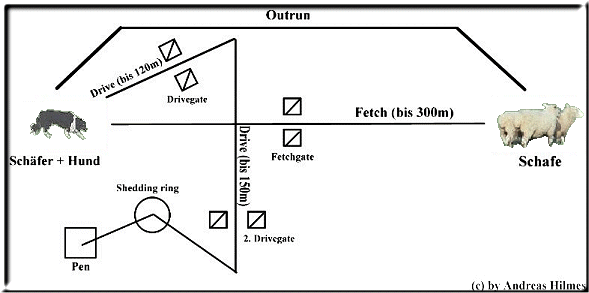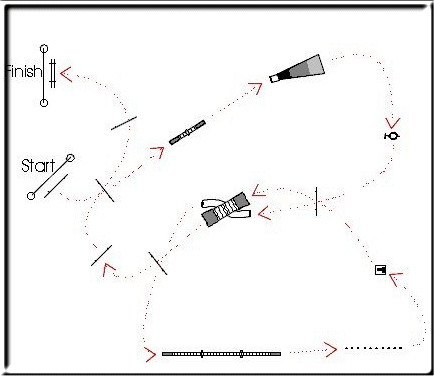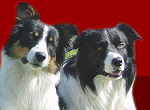
Herding
The original work a Border Collie had to do was herding sheep. He has been bred for this job for many years and it is desirable that this special capability in moving sheep and help the shepherd will be kept. There is no second breed in the world which has the will and ability to work in a way the Border Collie does. His intelligence, manoeuvrability but also his empathy make him the most popular herding dog in the world. The shepherds in Great Britain started very early to compete in herding trials against each other, to find out whose dog is the best in working with the sheep. A win at such a tournament brought a great improve of prestige and reputation. This trials soon became very popular and many visitors even on TV take part in such events today. The following sentences will describe what the dogs have to do at a sheepdog trial. There are three categories a dog can start in depending on his capabilites: Novice, Advanced and the so called Open Class, where the best dogs start in. The course basically looks identical, but can vary from area to area. What the dog exactly has to do and the time he has to do it in depends of the category where he starts in. It’s clear that a beginner dog has the easiest job. Every run is split into parts. The handler gives the commands, but does not run with the dog of course. The judges will give points for every part of the run, better said there is a maximum of points a dog can get and with every mistake the judges will subtract points.
The following graphic will show you how a run looks like:
First the dog runs out to get behind the sheep (Outrun). He carefully comes close to the sheep and starts to drive them back to the shepherd (Lift). He directs the sheep through the Fetchgate (Fetch). Being close to the shepherd, the dogs drives the sheep away from the handler through the Drivegate (Drive)and then crosswise along through the second Drivegate. To separate the dogs they are moved into the Shedding Ring (Shed). After that they will be coop up (Pen).
Agility
Agility celebrated his 20th birthday in 1998. This sport was first seen at the Cruft’s dogshow in February of 1978. John Varley was asked if he was able to entertain the visitors with a funny program in the main hall. He should do it in between the break of the Obedience-demonstration and the judging of the dogs. Johns interest was the horse sport and so he tried something for the dogs similar to the jumping events for the horses. Together with Peter Meanwhile he transferred the jumps into the dogworld and so Agility was born in it’s basic idea. The spectators loved the great demonstration the two pioneers have shown with their greatly trained dogs. Some years later Agility became popular in the United States. There are four big Agility organizations (USDAA, NADAC, AKC and UKC) and some more smaller ones, showing how important this sport was getting through the years. In Germany Agility gets more and more popular as well. It developed into a dogsport for masses and there are German Championships being held every year. Lots of spectators can be seen at this tournaments. This events are held under the umbrella organization of the VDH and DVG. The Agility team of Germany is very succesful at
the world championships each year and lots of Border Collies are the competitors.
The following graphic shows a simple Agility parcours (description below):
After the start there is a jump, then the seesaw, then the sack tunnel, the tyre, the normal tunnel, the footbridge, the table, the steep wall, then three jumps in a row and that was it. The time the dog needs is taken at the start/finish lane.
Obedience
Like many other sports for dogs, Obedience was developed in England. Still in it’s early days in germany, more and more people try it out with their dogs. Doing Obedience means to work in harmony and perfection together with the dog. A very good relationship between the human being and the dog is very important, else you won’t be succesful in this sport. Necessarily needed is that the dog obeys perfectly. It should be able to do a perfect stand, sit and stay for many obedience-excercises need this commands. The other part is the heelwork, the dog should walk very close to your legs being attentive. Other elements are the distance control, the scent, the send on ahead, the recalls and the retrieve. Lots of training is needed to do perfect distance control for example. You can do Obedience with every breed in all ages. This method in educating the dog means to work positive and without pressure on the dog. The dog should do the excercises because he likes them and wants to please his owner. Of course the Border Collie is a very talented breed for Obedience, being very sensitive and intelligent. Have a look at the books page and the title of Brian McGovern to learn more about this great sport.
Flyball
Like all crazy sports Flyball was developed in the USA, in the seventies in California. There and in Canada this sport developed quickly like Agility in Germany during the years. Today it is popular in Europe as well, but especially in Germany tournaments are very rare. Flyball is a quite easy sport. You need 4 jumps and a flyball box. In the box there is a tennis ball the dog has to fetch in releasing the mechanism that makes the ball fly out of the machine. Two teams of 4 dogs compete against each other on two parallel built parcours. One dog starts after each other and has to bring the ball to his owner, crossing the line the second dog is allowed to start and so on. It is important that all dogs bring the ball back
without any mistake. The fastest team wins of course.
Dogdancing
Dogdancing is a form of the freestyle obedience. The dog has to be able to do a great heelwork to build a nice dogdancing choreography. Out of the heelwork the dog can do lots of tricks like weaving way through the legs, twists, walking backwards, doing rolls, giving paw and so on. Dogdancing is very similar but not the same as heelwork to music. Mary Ray is one of the best trainers in the world here. Dogdancing allows the handlers to be very creative, the more unusual the better. It’s not very hard to learn tricks, but it is very difficult to build a good choreography that fits to the music. Sandra Davis from America is one of the best dogdancers in the world. In germany dogdancing can be seen as demonstrations at dogshows, competitions are very rare.
Frisbee Freestyle
This is a popular sport especially in the USA. In Germany people do it just for fun, of course Border Collies love to chase the frisbee, like bringing back the ball, maybe a result of the herding instinct. You should just use a frisbee of a very high quality to prevent injuries in your dogs mouth. Don’t start that early with that sport because the young dog is not allowed to jump that much. Playing frisbee is great fun for the dogs and their muscles are well trained doing this.
Rescue dogs
A very meaningful occupation is using the dog as a rescue dog, here the Border Collie can be educated to save lifes! Courage, strong nerves and a good relationship to the owner are very important. Besides the tracking stamina and dexterity are needed. The dog learns to be able to track down human beings and notify his handler. The dog must be able to move safely in difficult areas.
Other things
Of course there is much more a Border Collie is able to do. Take him with you for bicycling, jogging tours and even let him run next to your horse, if you have one. Your dog will love you for each activity you do together with him. The most important thing is that both human being and his dog have fun together and live a life that satisfies all needs. Be creative with your dog and try to think of new things from time to time, to give the dog an eventful life.

Breeding Faith Shane Fellow Border Collie Keeping Training Questions
Pictures Videos Poetry Contact About us Guestbook Books Links


